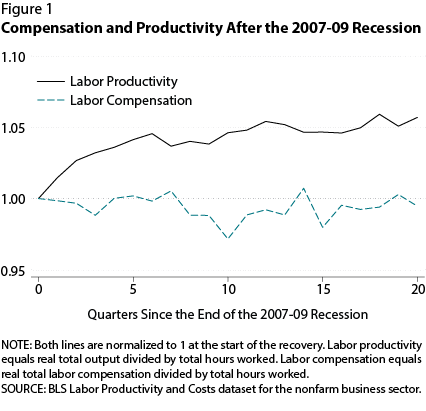Labor Compensation and Labor Productivity: Recent Recoveries and the Long-Term Trend
by B. Ravikumar and Lin Shao
Economic Synopses, No. 16, 2016.
The widening gap between labor productivity and compensation is not unique to the current recovery.
Labor compensation has grown slowly during the recovery of the U.S. economy from the 2007-09 recession. Real labor compensation per hour in the nonfarm business sector was 0.5 percent lower 20 quarters after the start of the recovery.1 The sluggish growth in labor compensation was one of the biggest concerns for monetary policymakers (Yellen, 2015). As recently as June 2016, Fed Chair Janet Yellen (2016) remarked that signs that labor compensation growth might be picking up are tentative.
Economic theory suggests that firms pay workers according to their productivity. That is, workers’ compensation reflects the value of the goods and services they produce. One might then wonder whether the slow growth in labor compensation is simply due to slow growth in labor productivity.2 In this essay, we compare labor compensation and labor productivity during the recovery from the 2007-09 recession with that from the previous recession and the long-term trend. We measure labor productivity as real total output divided by total hours worked and labor compensation as real total labor compensation divided by total hours worked.

Figure 1 plots labor productivity and compensation for the nonfarm business sector for 20 quarters after 2009:Q2 (the start of the recovery from the 2007-09 recession according to the National Bureau of Economic Research [NBER]). As the figure shows, labor compensation decreased by 0.5 percent during this period but labor productivity increased by 6 percent.

Is the disparity between labor productivity and labor compensation unique to the recovery from the recent recession? As Figure 2 shows, it is not: The growth in labor compensation was also consistently lower than that in labor productivity during the recovery from the 2001 recession. Twenty quarters after 2001:Q4 (the start of the recovery according to the NBER), labor productivity was 13 percent higher, while labor compensation was only 5 percent higher.

In fact, labor productivity has been growing at a higher rate than labor compensation for more than 40 years. As Figure 3 shows, labor productivity in 2016:Q1 is 3.8 times as high as that in 1950:Q1; labor compensation, on the other hand, is only 2.7 times as high. In other words, the gap between labor productivity and compensation has been widening for the past four decades (see Domenech, 2015, and Fleck, Glaser, and Sprague, 2011, for discussions of the widening gap). The slower growth in labor compensation relative to labor productivity during the recovery from the two most recent recessions is part of this long-term trend.
The data in Figure 3 show that the productivity-compensation gap—defined as labor productivity divided by labor compensation—has been increasing on average by approximately 0.9 percent per year since 1970:Q1. Based on this long-term trend, the gap would have been 51 percent higher in 2016:Q1 compared with 1970:Q1; in the data, the gap is actually 47 percent higher.
In conclusion, labor compensation failed to catch up with labor productivity after the 2007-09 recession. However, the driving force behind it is not unique to the recent recession but is part of a long-term trend of a widening productivity-compensation gap.
Notes
1 According to the Bureau of Labor Statistics (BLS), the nonfarm business sector is a subset of the domestic economy, excluding government, private households, and nonprofit organizations. Labor compensation includes wages and salaries, employer contributions for social insurance, and employer payments to employee-benefit plans (including health and life insurance). See the BLS glossary (http://www.bls.gov/bls/glossary.htm) for details.
2 See Economist (2014) for a discussion about wage stagnation and labor productivity.
References
Domenech, Benjamin. “The Truth about ‘Wage Stagnation.’” Commentary, March 1, 2015; https://www.commentarymagazine.com/article/the-truth-about-wage-stagnation.
Economist. “The Big Freeze.” September 6, 2014; http://www.economist.com/news/finance-and-economics/21615589-throughout-rich-world-wages-are-stuck-big-freeze.
Fleck, Susan; Glaser, John and Sprague, Shawn. “The Compensation-Productivity Gap: A Visual Essay.” Bureau of Labor Statistics Monthly Labor Review, January 2011, pp. 57-69; http://www.bls.gov/opub/mlr/2011/01/art3full.pdf.
Yellen, Janet. “Semiannual Monetary Policy Report to the Congress.” February 24, 2015; http://www.federalreserve.gov/newsevents/testimony/yellen20150224a.htm.
Yellen, Janet. “Semiannual Monetary Policy Report to the Congress.” June 21, 2016; http://www.federalreserve.gov/newsevents/testimony/yellen20160621a.htm.


What's been said:
Discussions found on the web: